Optical AWL
Remote flash units can be controlled via optical signals (optical AWL) from the built-in flash or an optional flash unit mounted on the camera accessory shoe.
Built-in Flash/SB-500
Use the built-in flash or an optional SB-500 as a master flash controlling remote flash units.
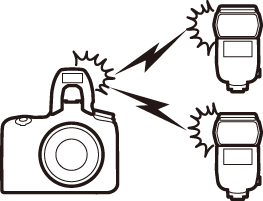
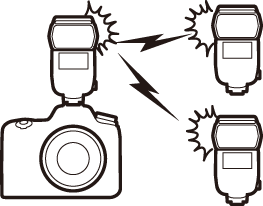
-
C: Raise the built-in flash.
Press the M (Y) button to raise the built-in flash. If you will be using an SB-500 as the master flash, mount it on the camera accessory shoe.

-
C: Enable optical AWL.
In the photo shooting menu, select Optical AWL for Flash control > Wireless flash options.
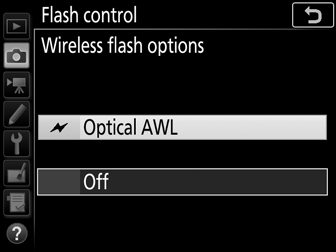
-
C: Select Group flash options.
Select Flash control in the photo shooting menu, then highlight Group flash options and press 2.
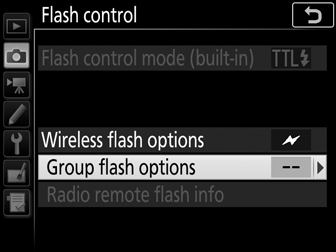
-
C: Choose the flash control mode.
Choose the flash control mode and flash level for the master flash and the flash units in each group:
- TTL: i-TTL flash control.
- qA: Auto aperture (available only with compatible flash units; note that the built-in flash and SB-500 are not compatible with auto aperture).
- M: Choose the flash level manually.
- – – (off): The units do not fire and the flash level can not be adjusted.
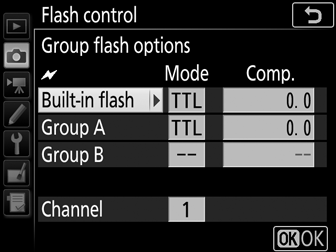
Choose a channel for the master flash. If the remote flash units include an SB-500, you must choose channel 3, but otherwise you can choose any channel between 1 and 4.
-
f: Set the channel.
Set the remote flash units to the channel selected in Step 4.
-
f: Group the remote flash units.
Choose a group (A or B) for each remote flash unit. Although there is no limit on the number of remote flash units that may be used, the practical maximum is three per group. With more than this number, the light emitted by the remote flash units will interfere with performance.
-
C/f: Compose the shot.
Compose the shot and arrange the flash units. See the documentation provided with the flash units for more information. After arranging the units, press the test buttons on the flash units to confirm that all flash units are functioning.
-
C/f: Take photographs.
Confirm that the ready lamps on all flash units are lit before each shot.
Other Flash Units
For information on using optical AWL with other flash units, see the manual provided with the flash unit.
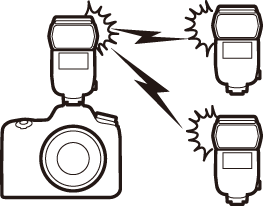
Optical AWL
Position the sensor windows on the remote flash units to pick up the light from the master flash (particular care is required if the camera is not mounted on a tripod). Be sure that direct light or strong reflections from the remote flash units do not enter the camera lens (in TTL mode) or the photocells on the remote flash units (qA mode), as this may interfere with exposure. To prevent low-intensity flashes emitted by the master flash from appearing in photographs taken at short range, choose low ISO sensitivities or small apertures (high f-numbers). After positioning the remote flash units, take a test shot and view the results in the camera monitor.
Flash Compensation
The flash compensation value selected with the M (Y) button and sub-command dial is added to the flash compensation values selected in the wireless flash options menu. Y icons are displayed in the control panel and viewfinder when a flash compensation value other than ±0 is selected for the master or remote flash units in TTL or qA mode.
